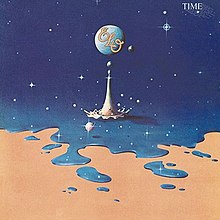| Time | ||||
|---|---|---|---|---|
 | ||||
| Studio album by | ||||
| Released | 31 July 1981[1] | |||
| Recorded | Early 1981 | |||
| Studio | Musicland Studios (Munich, West Germany) Polar Studios (Stockholm, Sweden) | |||
| Genre | ||||
| Length | 43:38 | |||
| Label | ||||
| Producer | Jeff Lynne | |||
| ELO chronology | ||||
| ||||
| ELO studio album chronology | ||||
| ||||
| Singles from Time | ||||
| ||||
Time is the ninth studio album by English rock band Electric Light Orchestra (credited as ELO), released in July 1981 on Jet Records. It is a concept album about a man from the 1980s who is taken to the year 2095, where he is confronted by the dichotomy between technological advancement and a longing for past romance.[7] The record topped the UK Albums Chart for two weeks, though it attracted mixed reviews for its heavy use of synthesizers and stylistic shift away from the orchestral rock of previous ELO albums. It has since gained a cult following, particularly among retrofuturist enthusiasts.
Time is a work of synth-pop that combines elements from 1950s music, new wave, reggae, rockabilly, the Beatles, Phil Spector and the Shadows. The album signalled a departure from the band's sound by emphasising electronics over its usual orchestra. It is also the band's second concept album, the first being Eldorado in 1974.[2] The music video created for its lead single, "Hold On Tight", was the most expensive ever made to that point, with a budget of approximately £40,000.[8] Four more singles followed the album's release: "Twilight", "Ticket to the Moon" (backed with "Here Is the News"), "Rain Is Falling" and "The Way Life's Meant to Be".
The record is considered the first major concept album devoted to time travel as well as ELO's most influential album.[6] The "Prologue" and "Twilight" tracks were used in the 1983 anime opening animation Daicon IV. In 2001, a CD reissue of Time included three additional tracks that were originally left off the LP.
- ^ "BPI certifications for ELO".
- ^ a b Cite error: The named reference
PMwas invoked but never defined (see the help page). - ^ Elliott, Paul (19 December 2016). "Every Electric Light Orchestra Album Ranked Worst To Best". Team Rock.
- ^ "Da riscoprire: la storia di "Time" della Electric Light Orchestra". Rockol (in Italian). 2 April 2016.
- ^ Roberts, Adam (2005). The History of Science Fiction. Springer. p. 336. ISBN 978-0-230-55465-8.
- ^ a b Cite error: The named reference
Guardian2016was invoked but never defined (see the help page). - ^ VanderMeer, Ann; VanderMeer, Jeff (18 March 2014). The Time Traveler's Almanac. Tom Doherty Associates. p. 671. ISBN 978-0-7653-7421-9.
- ^ UK Midlands Central TV News, August 1981[better source needed]